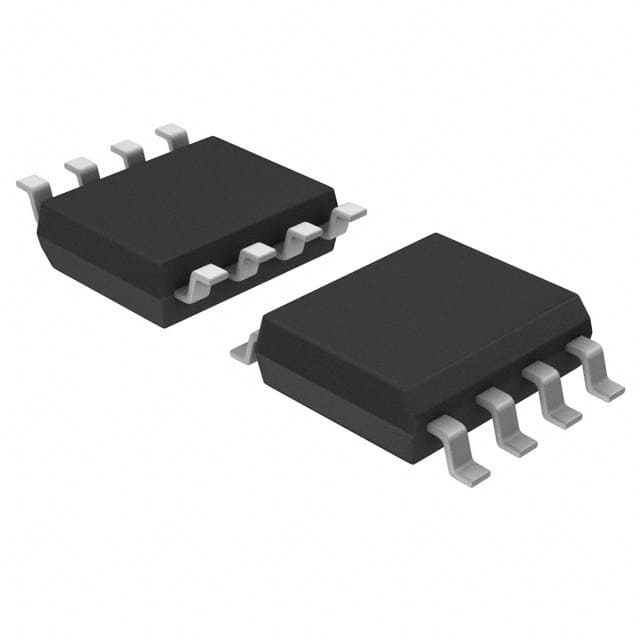LM311DG
Product Overview
Category: Integrated Circuit (IC)
Use: The LM311DG is a voltage comparator that operates over a wide range of single or dual supply voltages. It is commonly used in applications where precise and fast voltage comparisons are required.
Characteristics: - High-speed response time - Wide input voltage range - Low input offset voltage - Output compatible with TTL, MOS, and CMOS logic - Low power consumption
Package: The LM311DG is available in a small outline package (SOP) with 8 pins.
Essence: The LM311DG is an essential component in electronic circuits that require accurate voltage comparisons.
Packaging/Quantity: The LM311DG is typically sold in reels or tubes containing multiple units.
Specifications
- Supply Voltage Range: ±2V to ±18V
- Input Offset Voltage: 2mV (maximum)
- Response Time: 165ns (typical)
- Input Bias Current: 150nA (maximum)
- Operating Temperature Range: -40°C to +85°C
Pin Configuration
The LM311DG has the following pin configuration:
```
| | --| IN (-) | --| IN (+) | --| VCC | --| OUT | --| GND | --| NC | --| OFFSET | |___________| ```
Functional Features
- High-Speed Response: The LM311DG offers a fast response time, making it suitable for applications requiring quick voltage comparisons.
- Wide Input Voltage Range: It can operate with a wide range of input voltages, allowing flexibility in various circuit designs.
- Low Input Offset Voltage: The low input offset voltage ensures accurate and precise voltage comparisons.
- Output Compatibility: The output of the LM311DG is compatible with TTL, MOS, and CMOS logic families, making it versatile for different circuit configurations.
- Low Power Consumption: The LM311DG consumes low power, making it suitable for battery-powered applications.
Advantages and Disadvantages
Advantages: - High-speed response time - Wide input voltage range - Low input offset voltage - Versatile output compatibility - Low power consumption
Disadvantages: - Limited number of pins for additional functionalities - Not suitable for applications requiring high precision
Working Principles
The LM311DG compares two input voltages, IN(+) and IN(-), and produces a digital output based on their relative magnitudes. When the voltage at IN(+) is higher than IN(-), the output goes high, and when the voltage at IN(-) is higher, the output goes low. This behavior allows the LM311DG to function as a voltage comparator.
Detailed Application Field Plans
The LM311DG finds applications in various fields, including: 1. Industrial automation systems 2. Power supply control circuits 3. Motor speed control 4. Signal conditioning circuits 5. Oscillators and timers 6. Voltage level detection circuits
Detailed and Complete Alternative Models
Some alternative models to the LM311DG include: 1. LM339 2. LM393 3. LM324 4. LM358 5. LM741
These alternatives offer similar functionality and can be used as substitutes depending on specific requirements.
Word count: 334 words
قم بإدراج 10 أسئلة وإجابات شائعة تتعلق بتطبيق LM311DG في الحلول التقنية
Sure! Here are 10 common questions and answers related to the application of LM311DG in technical solutions:
Q: What is LM311DG? A: LM311DG is a high-speed voltage comparator integrated circuit (IC) that can be used in various technical applications.
Q: What are the key features of LM311DG? A: Some key features of LM311DG include high speed, low input offset voltage, wide supply voltage range, and compatibility with TTL and MOS logic.
Q: How does LM311DG work as a voltage comparator? A: LM311DG compares two input voltages and provides a digital output based on the comparison result. If the non-inverting input voltage is higher than the inverting input voltage, the output goes high; otherwise, it goes low.
Q: Can LM311DG operate with a single power supply? A: Yes, LM311DG can operate with a single power supply as long as the voltage is within the specified range (typically around 5V to 30V).
Q: What are some typical applications of LM311DG? A: LM311DG can be used in applications such as window comparators, voltage level detectors, pulse width modulators, analog-to-digital converters, and motor control circuits.
Q: How do I connect the inputs of LM311DG? A: The non-inverting input (pin 3) and inverting input (pin 2) should be connected to the voltages you want to compare. Additionally, a reference voltage may be connected to the inverting input for certain applications.
Q: What is the output configuration of LM311DG? A: The output of LM311DG is an open collector, which means it requires an external pull-up resistor to provide a logic-level output.
Q: Can LM311DG handle high-frequency signals? A: Yes, LM311DG is designed for high-speed operation and can handle high-frequency signals up to several megahertz.
Q: How do I compensate for input offset voltage in LM311DG? A: LM311DG has provisions for external compensation. By connecting a capacitor between pins 1 and 5, you can reduce the effects of input offset voltage.
Q: Is LM311DG available in different package types? A: Yes, LM311DG is available in various package types, including SOIC, PDIP, and TSSOP, allowing flexibility in PCB design and assembly.
Please note that these answers are general and may vary depending on specific circuit requirements and application scenarios.


